By Bianca Schulze, The Children’s Book Review
Published: April 1, 2011
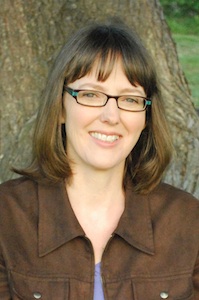
Deborah Underwood is the New York Times bestselling author of The Quiet Book, The Loud Book, A Balloon for Isabel and Granny Gomez and Jigsaw. She lives in San Francisco, California.
TCBR: Your first three picture books were released in 2010: A Balloon for Isabel, Granny Gomez and Jigsaw and The Quiet Book. How did it come about that they all released in the same fantastic year?
Deborah Underwood: I sold Granny in 2003, and Isabel and The Quiet Book in 2008—all to different publishing houses—so it was just a strange publishing quirk that they came out during a two-month period last year. What’s more, I initially wrote Isabel in 2004, but it was one of those books that just took a long time to gel. It sat in my virtual drawer for a few years before I pulled it out again and got it into marketable shape. It was great to see all those projects finally come to fruition.
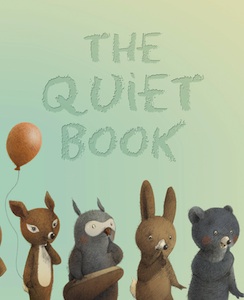 I can only imagine! Word is that it’s hard to get a book published that is considered “too quiet.” Was this book your hardest sell? And, this being the case is it satisfying to know that The Quiet Book is a New York Times bestseller?
I can only imagine! Word is that it’s hard to get a book published that is considered “too quiet.” Was this book your hardest sell? And, this being the case is it satisfying to know that The Quiet Book is a New York Times bestseller?
It certainly wasn’t an easy sell. You’re absolutely right about publishers shying away from “quiet” books; in fact, “too quiet” is a common rejection-letter line. I’m grateful that my editor saw the potential in the manuscript and was willing to go against the prevailing non-quiet trend. And yes, given that quiet books are hard to sell, the success of The Quiet Book is extra-sweet. I hope it helps open the door for other writers who want to write quiet picture books.
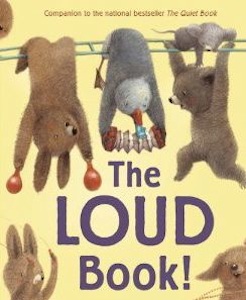 It makes sense that The Loud Book should follow closely behind its predecessor. Were you surprised at how quickly it came to fruition?
It makes sense that The Loud Book should follow closely behind its predecessor. Were you surprised at how quickly it came to fruition?
We actually started working on The Loud Book well before The Quiet Book came out. I was rewriting the text during the summer of 2009. I feel fortunate that the folks at Houghton Mifflin had enough faith in The Quiet Book to sign a sequel before it was released.
Bravo to Houghton Mifflin for having such great foresight. Of all the quiet and loud moments featured in your books, which are you favorites?
Ooh, good question! My favorite quiets are probably “first snowfall quiet,” “car ride at night quiet,” and “best friends don’t need to talk quiet.” One of my favorite illustrations is for “trying not to hiccup quiet,” where the hiccuping bunny is being held upside-down by a bear. I have no idea how Renata came up with that–maybe it’s a traditional bear folk remedy for hiccups–but it’s hilarious!
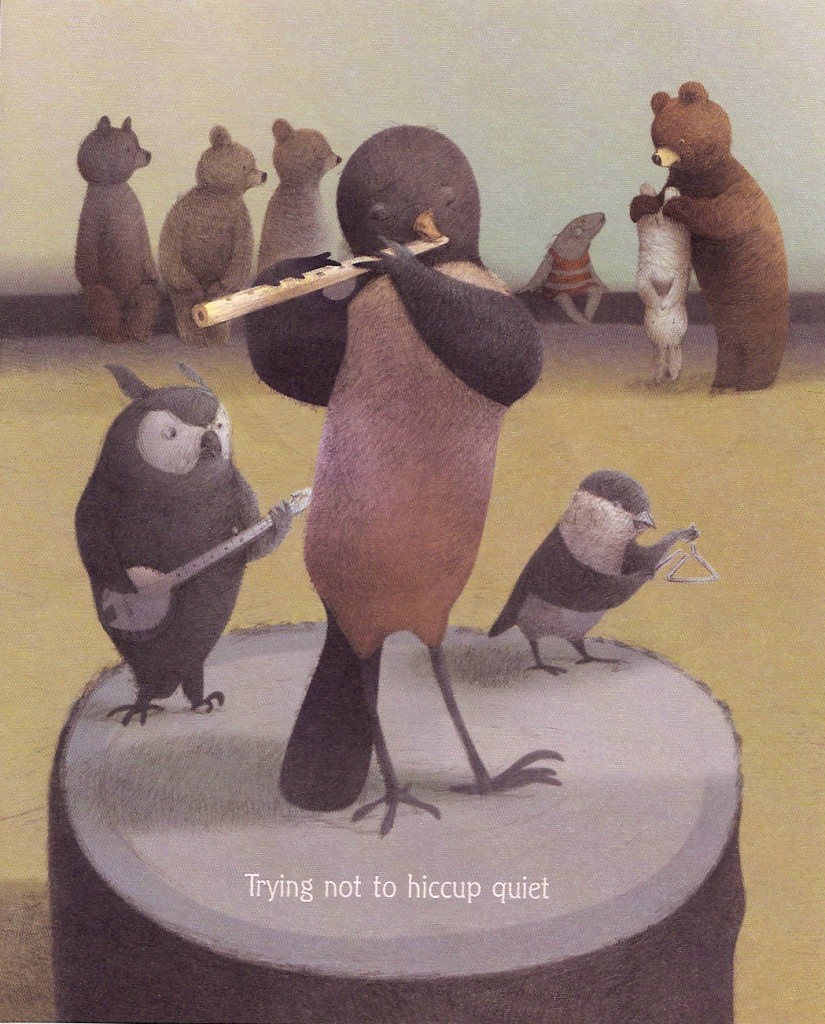
In terms of louds, I’m fond of both “crackling campfire loud” and “fireworks loud.” Renata’s fireworks illustration took my breath away the first time I saw it.
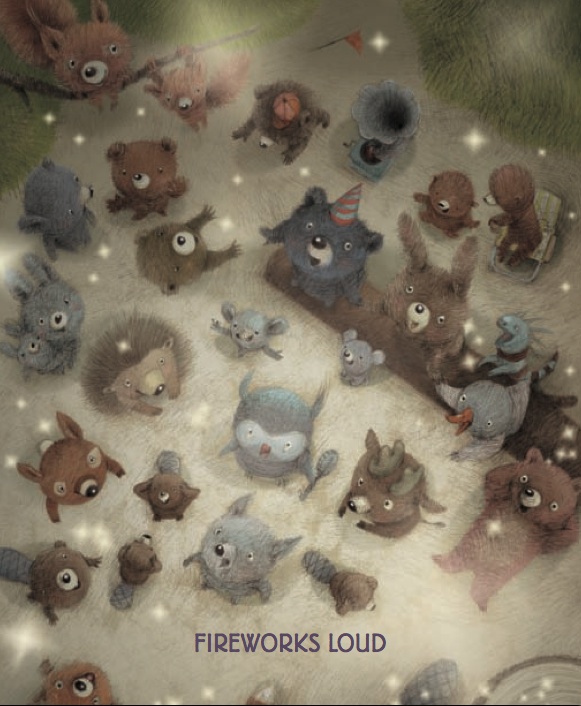
Renata Liwiska’s illustrations are awe-inspiring. Are there any moments missing from your books that, from an editorial standpoint, just didn’t make the cut?
Yup. I kind of liked “drowning out the thunder loud”—I envisioned kids marching around banging pots and pans—but neither my [critique] groups nor my editor was crazy about it, and I realize now they were right. “Dad pretending to be an orchestra conductor loud” was another casualty, although I think that one could have been funny. For Quiet, “cat sleeping in your lap quiet” and “watching stars quiet” didn’t make it.
Ooh, “watching stars quiet”—I can picture a beautiful illustration for that one. Each of your books tackle realistic issues, sensitivities, and moments, that most children will or have experienced. What messages do you hope readers will take away from each of your books?
When I wrote the books, messages weren’t even on my radar. Writing with the purpose of teaching kids something can backfire and result in a preachy manuscript. But after Quiet came out, I realized it may have been informed by my interest in meditation, and by my concern about everyone being so overloaded with input these days. If The Quiet Book helps kids recognize and appreciate the various quiet moments in their lives, I’ll be thrilled.
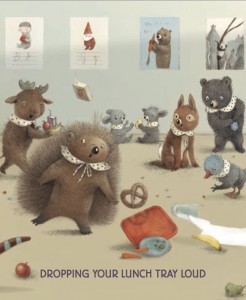
For Loud, as for Quiet, I wanted to take kids on an emotional journey, to evoke a variety of feelings that I hope they’ll be able to relate to. I think it’s nice for kids to know that they aren’t the only ones who have experienced, for example, the embarrassment of dropping a lunch tray.
That’s me. I’m that kid! Thank goodness I review children’s books—I could never make it as a waitress. Before your picture books were published, you dabbled in greeting cards, puzzles and screenplays. What made you commit to writing picture books specifically?
During a vacation in Cornwall in the 1990’s, I picked up a picture book in a gift shop (The Mousehole Cat by Antonia Barber, with spectacular illustrations by Nicola Bayley) and found it very emotionally moving. Until that moment, I don’t think I’d realized how powerful the combination of words and images in a picture book could be. That’s when I said, “This is what I want to do.”
Could you tell us about the picture book boot camp that you set up for yourself? And why you did this?
Although I’d decided I wanted to write picture books, I wasn’t very familiar with the genre, and I knew I needed to be. So I started off by reading 10 picture books a week and recording them on a massive spreadsheet. I tried to figure out why I liked—or didn’t like—each book I read. I read books about writing, joined The Society of Children’s Writers and Illustrators, went to conferences, and joined critique groups. I wanted to bulk up my credits, so I wrote educational passages for testing companies, work-for-hire nonfiction books, and stories and poems for children’s magazines. As I did all this, my writing got stronger, and I learned a lot about editing and the publication process.
You often say that you are still in-touch with your inner six-year-old and this is what helps you with your picture book writing. Why do you think that is? And how would you encourage other children’s book writers to do so—be in-touch with their inner-child, that is?
I think it’s just the way I am. My theory is that most children’s authors have inner children, and we’re drawn to writing for that age. My inner child is a precocious six-year-old who is an excellent reader, so I’m happy writing up to middle-grade novels. But I have no interest at all in writing YA (young adult) books.
Verbal play and just being goofy helps my creative process. So does being around animals, whether they’re the pigs and turkeys at my favorite animal sanctuary or the squirrels and ducks in the park. And I highly recommend field trips. I spent a lovely day at the Exploratorium recently, and I can go to Disneyland alone for several days and be as happy as a clam.
Kids seem so much more connected to wonder and awe than most adults are, and I think it’s good to remind ourselves what that feels like. Doing things we did as kids can help nurture our inner children, too. Nothing takes me back like the smell of Play-doh!
Is there anything else that you would like to share with your readers?
I’d like to say a huge thank you to everyone who’s supported my books. I understand that writing for kids is a great honor and a great responsibility, and I’ll do my best to write books worthy of kids’ attention.
And thank you so much for this interview opportunity!
You are very welcome!
Giveaway: Thanks to Houghton Mifflin, you can enter to win a piece of original art by Renata Liwska!
For more interviews and other fun stuff, visit: https://www.deborahunderwoodbooks.com/
As the interview closes, a final “quiet” moment …
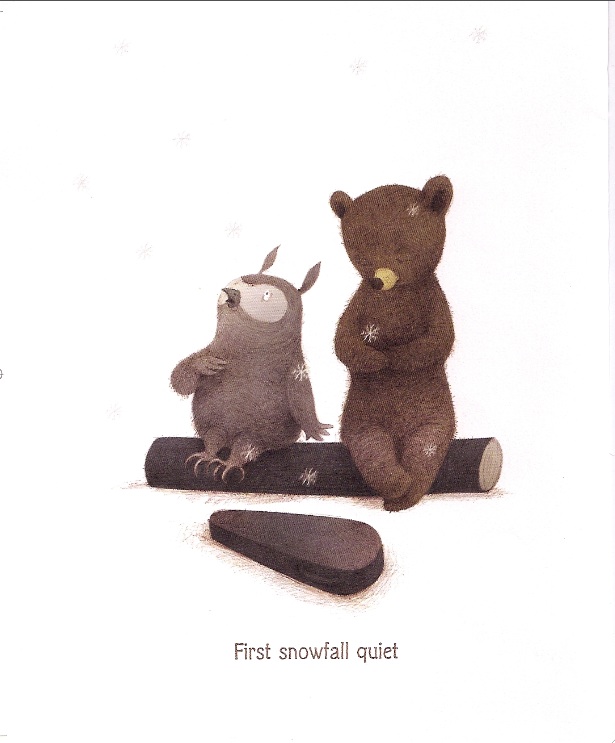
This interview with Deborah Underwood, author of The Quiet Book and The Loud Book, was conducted by Bianca Schulze. For similar books and articles, follow along with our content tagged with Deborah Underwood, and Picture Books.

4 Comments
Wonderful interview. I first saw The Quiet Book in the bookshop at Spirit Rock Meditation Center while looking for books for kids about meditation. What a brilliant way to help children connect with the power of silence. Thank you!
You know that these are special books when all you can think of as a writer is….I wish I’d come up with that idea! Children, with their fresh ears, are particularly sensitive to all the noise in our world. Sound, (and thankfully, lack of it), are universal experiences; how wonderful that Deborah has tapped into our relationship with them. Congratulation on you r publication day for The Loud Book, Deborah!
Deborah and Bianca, thank you for the delightful post and shared enthusiasm. Time to create a spread sheet. Thanks for the inspiration!
I’m so glad you enjoyed this interview. I think Deborah and her books are wonderful. Good luck with your spreadsheet!